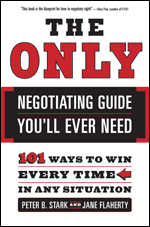Click here for printable version.
“Any business arrangement that is not profitable to the other person, will, in the end, prove unprofitable for you.”
-B. C. Forbes
In last month’s Master Negotiator, we advised against the tactic of walking away from a deal. Specifically, we referenced that win-win negotiation is about getting what you want, but also ensuring that the needs of your counterpart are met. Why is the success of your counterpart critical? Because, in real life negotiations, chances are good that you will negotiate more than once with the same counterpart: for example, with your boss, a coworker, family member or friend. When either party walks away, whether they choose to or are forced to by an un-yielding counterpart, bridges are burned and ties are cut. Last month, we urged our readers to use the walk away strategy cautiously for this reason. According to recent news, even super giant Wal-Mart is not immune to the problems that arise from walking away in negotiations.
Please feel free to contact us with any negotiation questions or article ideas. We’ll do our best to address them in upcoming issues. (peter@peterstark.com)
Remember, almost everything in life is negotiable.
Peter B. Stark & Jane Flaherty
For years, manufacturers’ or distributors’ biggest reasons for celebration was landing the Wal-Mart account. But the story that is not told often is about the pressure that Wal-Mart puts upon its suppliers to bring “everyday low prices” to their customers. It is common knowledge that whatever price Wal-Mart sets for products from each of its 21,000 suppliers this year, the price will be lower next year. And, if the supplier doesn’t agree to the lower price, you can guarantee that Wal-Mart will threaten to remove all of that supplier’s products from their shelves. Wal-Mart tells the companies when they are no longer willing to buy their products that they are working on the art of SKU optimization, and your SKU’s are no longer being utilized.
There is some good news in these hardball negotiations. First, there is no doubt that customers have benefited from Wal-Mart’s drive to have suppliers squeeze their profits. Second, some have even said that Wal-Mart is partly responsible for helping the U.S. keep a lid on inflation. And third, if you are a supplier to Wal-Mart, they will force you to lower your price which will force you to become more efficient, leaner, faster and more productive.
So, how can Wal-Mart do this to both huge and small companies, even those who have products that are strong household names? It’s easy. Wal-Mart is the world’s biggest company. Wal-Mart is bigger than Exxon Mobil, General Electric and General Motors combined. It does more retail business than Target, Sears, Kmart, J.C. Penny, Safeway and Kroger combined (Fast Company). The challenge for suppliers becomes a negotiating decision similar to the ones that a crack addict has to make. If you move forward with the decision, it feels good (take the fix and make the sale) but it destroys your health (physically and profitably). You know the decision of lowering your price is going to increase your sales, but most likely erode your profits. Why do companies move forward with their decision and cave into Wal-Mart’s demands? Like the crack addict, it feels so good. And, the thought of telling anyone you just lost your biggest customer hurts so badly.
Thirty days ago, I was planning to write this article and tell you that Wal-Mart was one of the few companies who effectively used this walk-away strategy in negotiations. Wal-Mart requires companies to lower their prices and then dumps them if they refuse. This seemed to work for Wal-Mart at first, because it’s obvious they have a much better BATNA (Best Alternative to a Negotiated Agreement) than their suppliers. As long as you never have to work with your counterpart again, as I imagine Wal-Mart believed they would not, this is a highly effective strategy.
Some of their suppliers have even gone out of business or bankrupt when Wal-Mart utilized their walking away strategy (The Loveable Company and Vlasic Pickles). So why should Wal-Mart even care about their suppliers? Because as Wal-Mart has since experienced, very seldom are negotiations one-time affairs.
On March 8th, Bloomberg reported that Wal-Mart is bringing back some of the very products they had walked away from and removed from their shelves. Why is Wal-Mart bringing back products that they had literally given the middle finger to? Because consumers were demanding a wider selection from which to make their purchases. The retailer said last month that its U.S. stores recorded a drop in sales and had a “slight decrease” in customer traffic in the quarter that ended in January. Even harder for Wal-Mart to acknowledge was the fact that consumers were shopping at other stores to find the products that Wal-Mart used to supply. Even I left Wal-Mart and headed for my local supermarket to buy some Purina dog treats that Wal-Mart had pulled from the pet food section. Bloomberg reported that Wal-Mart has now begun re-stocking products they removed from the categories of health and beauty suppliers, cereal, pet treats, soda, bedding and laundry detergent.
I started this article with the premise: if you are big enough and have a better BATNA, you can walk away and win. I end this article by stating a premise we have written about for twenty years: almost always in on-going relationships, it is better to develop a win-win outcome where the needs and goals of both parties have been achieved. Hopefully in round two of these negotiations, Wal-Mart will obtain the products their consumers are demanding, and the suppliers can obtain a price from Wal-Mart that keeps them successfully profitable.




Speak Your Mind